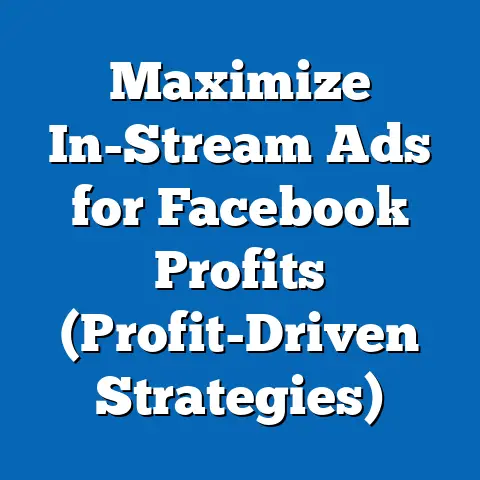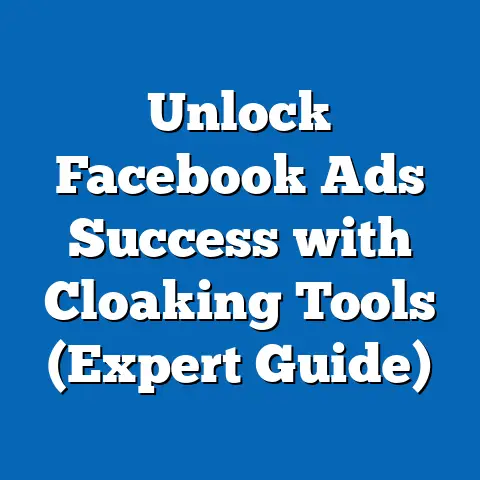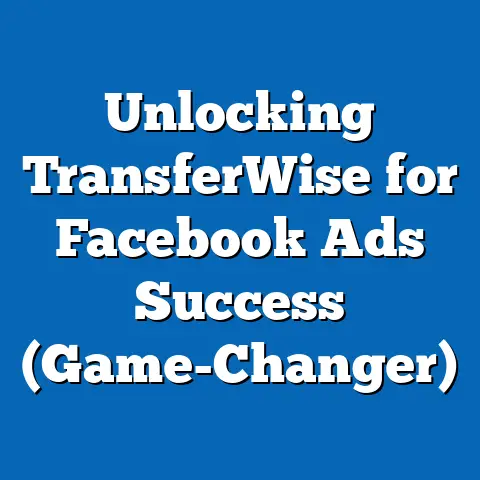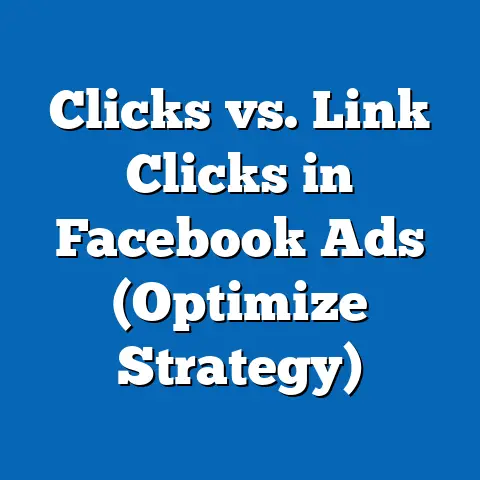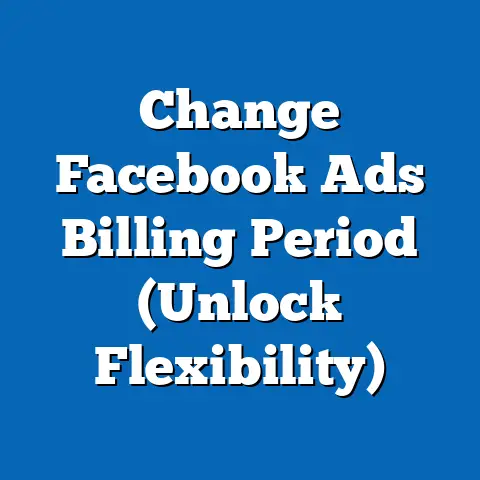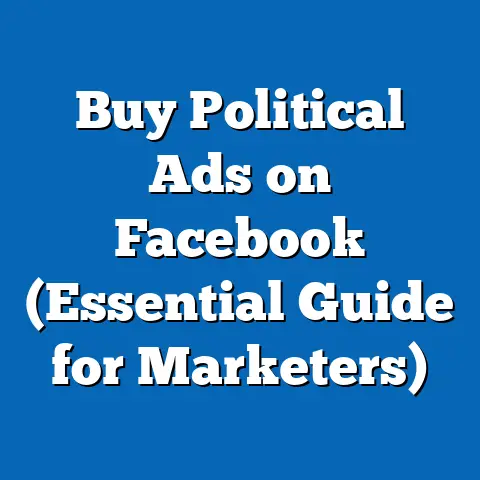Unlock Best Targeting for Facebook Ads (Expert Strategies)
I remember the first time I truly understood the power of precise Facebook ad targeting. I was working with a small e-commerce business that sold handmade jewelry. Their previous ad campaigns were broad, targeting generic interests like “fashion” and “accessories.” The results were… lackluster, to say the least. We were seeing a trickle of sales, but the ROI was barely breaking even.
Then, we dug deep. We analyzed their existing customer data, focusing on demographics, purchase history, and even the language they used in their reviews. We discovered that their ideal customer wasn’t just interested in fashion; they were passionate about sustainable, ethically sourced products. They were also active in specific online communities dedicated to artisan crafts.
We revamped our targeting strategy, focusing on these niche interests and creating custom audiences based on their existing customer list. The results were astounding. Within a month, their ROI tripled, and they were struggling to keep up with the demand. That experience cemented my belief that effective targeting is not just an option; it’s the foundation of any successful Facebook ad campaign.
Facebook advertising, when done right, can be a game-changer for businesses of all sizes. But simply throwing money at the platform and hoping for the best is a recipe for disaster. The key to unlocking its true potential lies in understanding and leveraging its powerful targeting capabilities. I’ve seen firsthand how a well-defined targeting strategy can transform a struggling campaign into a roaring success.
In fact, according to a recent study by HubSpot, targeted ads have a 74% higher conversion rate than generic ads. Think about that for a moment. Almost three-quarters more conversions simply by showing your ads to the right people! This underscores the critical importance of taking the time to understand and implement advanced targeting strategies on Facebook.
This is more than just a theoretical overview. I’ll provide practical, actionable steps that you can implement immediately to improve your Facebook ad campaigns. We’ll cover everything from understanding Facebook’s targeting capabilities to building effective strategies, utilizing advanced techniques, and continually testing and optimizing your approach. I’ll also share real-world case studies and success stories to illustrate the power of effective targeting.
So, buckle up and get ready to transform your Facebook ad campaigns. Let’s dive in and unlock the best targeting for your business!
Understanding Facebook’s Targeting Capabilities
Before you can craft an effective targeting strategy, you need to understand the vast array of options that Facebook offers. It’s like having a toolbox filled with specialized tools – knowing what each tool does and how to use it is essential for building a masterpiece.
Overview of Facebook’s Targeting Options
Facebook’s targeting options can be broadly categorized into three main groups:
- Core Audiences: This is your bread and butter. Core Audiences allow you to target users based on demographics, interests, and behaviors.
- Demographics: This includes basic information like age, gender, location, education, job title, relationship status, and language.
- Interests: This allows you to target users based on their expressed interests on Facebook, such as hobbies, favorite pages, and activities.
- Behaviors: This targets users based on their online activities, purchase history, device usage, and other behaviors.
- Custom Audiences: This is where things get really powerful. Custom Audiences allow you to target users based on your own data, such as email lists, website traffic, and app activity.
- Customer Lists: Upload your existing customer email addresses or phone numbers to target them directly on Facebook.
- Website Traffic: Retarget users who have visited your website or specific pages on your website.
- App Activity: Target users who have interacted with your mobile app.
- Engagement: Target users who have interacted with your Facebook page, ads, or videos.
- Lookalike Audiences: This takes your targeting to the next level. Lookalike Audiences allow you to reach new people who are similar to your existing customers or website visitors.
- Demographics: This includes basic information like age, gender, location, education, job title, relationship status, and language.
- Interests: This allows you to target users based on their expressed interests on Facebook, such as hobbies, favorite pages, and activities.
- Behaviors: This targets users based on their online activities, purchase history, device usage, and other behaviors.
- Customer Lists: Upload your existing customer email addresses or phone numbers to target them directly on Facebook.
- Website Traffic: Retarget users who have visited your website or specific pages on your website.
- App Activity: Target users who have interacted with your mobile app.
- Engagement: Target users who have interacted with your Facebook page, ads, or videos.
Understanding these different targeting options is the first step towards creating effective Facebook ad campaigns. Each option offers unique advantages and can be used in combination to create highly targeted audience segments.
I remember when I first started using Facebook ads, I was overwhelmed by the sheer number of targeting options available. It felt like trying to navigate a maze blindfolded. But once I started experimenting and understanding the nuances of each option, I realized the incredible potential it offered.
Deep Dive into Audience Insights
One of the most valuable tools in your Facebook ad targeting arsenal is Audience Insights. This tool allows you to gather data about your target audience’s demographics, interests, behaviors, and more. It’s like having a spyglass that lets you peek into the minds of your potential customers.
Audience Insights can help you:
- Understand your audience’s demographics: Discover their age, gender, location, education level, and job titles.
- Identify their interests: Learn about their hobbies, favorite pages, and activities on Facebook.
- Analyze their behaviors: Understand their purchase history, device usage, and other online behaviors.
- Discover their page likes: See which pages your audience likes on Facebook, which can provide valuable insights into their interests.
- Learn about their location: Understand where your audience lives and spends their time.
How to Access and Interpret Audience Insights:
- Go to Facebook Ads Manager: Navigate to the Facebook Ads Manager.
- Click on “Tools”: In the top navigation, click on “Tools” and select “Audience Insights.”
- Choose an Audience: You’ll be prompted to choose an audience to analyze. You can choose “Everyone on Facebook” or “People connected to your Page.”
- Explore the Data: Once you’ve chosen an audience, you’ll see a wealth of data about their demographics, interests, behaviors, and more.
Interpreting the Data:
- Demographics: Pay attention to the age and gender distribution of your audience. This can help you tailor your ad creative and messaging to resonate with them.
- Interests: Look for common interests among your audience. This can help you target users based on their passions and hobbies.
- Behaviors: Analyze their purchase history and online behaviors. This can help you target users who are likely to be interested in your products or services.
- Page Likes: Explore the pages your audience likes on Facebook. This can provide valuable insights into their interests and preferences.
- Location: Understand where your audience lives and spends their time. This can help you target users based on their location.
For example, let’s say you’re selling organic coffee beans. Using Audience Insights, you might discover that your target audience is primarily women aged 25-45, located in urban areas, interested in healthy living, and who like pages related to organic food and sustainable farming. This information can help you create highly targeted ad campaigns that resonate with your ideal customers.
Key Takeaway: Facebook’s targeting capabilities are incredibly powerful, but they can be overwhelming. Take the time to understand the different targeting options and use Audience Insights to gather data about your target audience. This will help you create highly targeted ad campaigns that drive results.
Next Steps:
- Explore the different targeting options available on Facebook.
- Use Audience Insights to gather data about your target audience.
- Start experimenting with different targeting combinations to see what works best for your business.
Building an Effective Targeting Strategy
Now that you understand Facebook’s targeting capabilities, it’s time to build an effective targeting strategy. This involves defining your audience, utilizing Custom Audiences, and implementing Lookalike Audiences. Think of it like constructing a building – you need a solid foundation and well-defined blueprints to create a structure that stands the test of time.
Defining Your Audience
Before you can target anyone, you need to know who you’re trying to reach. This involves creating detailed buyer personas that represent your ideal customers. A buyer persona is a semi-fictional representation of your ideal customer based on research and data about your existing customers.
Creating detailed buyer personas can help you:
- Understand your customers’ needs and motivations: What are their pain points? What are they hoping to achieve?
- Tailor your ad creative and messaging: How can you speak to their specific needs and motivations?
- Identify the best targeting options: Which demographics, interests, and behaviors are most relevant to your ideal customers?
How to Identify Your Ideal Customers:
- Analyze Your Existing Customer Data: Look at your existing customer data to identify common traits and patterns. What are their demographics? What are their interests? What are their purchase habits?
- Conduct Customer Surveys and Interviews: Reach out to your existing customers and ask them about their experiences with your brand. What do they like about your products or services? What could be improved?
- Research Your Competitors’ Customers: Analyze your competitors’ customers to identify potential new customers. What are their demographics? What are their interests?
- Use Facebook Audience Insights: As discussed earlier, Audience Insights can provide valuable data about your target audience’s demographics, interests, and behaviors.
Once you’ve gathered enough data, you can start creating detailed buyer personas. Each persona should include information such as:
- Name: Give your persona a name to make them feel more real.
- Age: What is their age range?
- Gender: What is their gender?
- Location: Where do they live?
- Occupation: What is their job title?
- Income: What is their income level?
- Interests: What are their hobbies and interests?
- Pain Points: What are their biggest challenges and frustrations?
- Goals: What are they hoping to achieve?
- Preferred Channels: Which social media platforms do they use?
For example, let’s say you’re selling eco-friendly cleaning products. One of your buyer personas might be “Sarah,” a 35-year-old mother of two who lives in a suburban area. She works as a marketing manager and earns a comfortable income. Sarah is passionate about sustainability and wants to create a healthy environment for her family. She’s frustrated with the harsh chemicals in traditional cleaning products and is looking for eco-friendly alternatives.
By creating detailed buyer personas like Sarah, you can better understand your target audience’s needs and motivations, and tailor your ad creative and messaging accordingly.
Utilizing Custom Audiences
Custom Audiences are one of the most powerful targeting options on Facebook. They allow you to target users based on your own data, such as email lists, website traffic, and app activity. This means you can reach people who have already shown an interest in your brand, making them more likely to convert.
There are several types of Custom Audiences you can create:
- Customer Lists: Upload your existing customer email addresses or phone numbers to target them directly on Facebook.
- Website Traffic: Retarget users who have visited your website or specific pages on your website.
- App Activity: Target users who have interacted with your mobile app.
- Engagement: Target users who have interacted with your Facebook page, ads, or videos.
How to Create Custom Audiences:
- Go to Facebook Ads Manager: Navigate to the Facebook Ads Manager.
- Click on “Audiences”: In the left navigation, click on “Audiences.”
- Click on “Create Audience”: Click on the “Create Audience” button and select “Custom Audience.”
- Choose a Source: Choose the source of your data, such as “Customer List,” “Website Traffic,” “App Activity,” or “Engagement.”
- Follow the Instructions: Follow the on-screen instructions to upload your data or connect your website or app to Facebook.
Examples of Businesses Successfully Leveraging Custom Audiences:
- E-commerce Business: An e-commerce business can upload their customer email list to target existing customers with special offers and promotions.
- Software Company: A software company can retarget users who have visited their website but haven’t signed up for a free trial.
- Mobile App Developer: A mobile app developer can target users who have downloaded their app but haven’t made a purchase.
- Local Restaurant: A local restaurant can target users who have engaged with their Facebook page with special discounts and promotions.
I once worked with a local bakery that was struggling to attract new customers. We created a Custom Audience based on their existing customer email list and targeted them with ads promoting their new seasonal menu. The results were incredible. The bakery saw a significant increase in sales and foot traffic.
Implementing Lookalike Audiences
Lookalike Audiences are a powerful way to reach new people who are similar to your existing customers or website visitors. Facebook uses its algorithm to identify users who share similar demographics, interests, and behaviors with your source audience.
Benefits of Lookalike Audiences:
- Reach new potential customers: Expand your reach beyond your existing customer base.
- Improve targeting accuracy: Reach people who are likely to be interested in your products or services.
- Increase conversion rates: Target users who are more likely to convert into customers.
How to Create Lookalike Audiences:
- Go to Facebook Ads Manager: Navigate to the Facebook Ads Manager.
- Click on “Audiences”: In the left navigation, click on “Audiences.”
- Click on “Create Audience”: Click on the “Create Audience” button and select “Lookalike Audience.”
- Choose a Source: Choose the source audience you want to use to create your Lookalike Audience. This could be a Custom Audience, a Facebook page, or a pixel.
- Select a Location: Choose the location you want to target with your Lookalike Audience.
- Choose an Audience Size: Choose the size of your Lookalike Audience. A smaller audience will be more similar to your source audience, while a larger audience will have a wider reach.
Tips on Effectively Creating and Optimizing Lookalike Audiences:
- Use high-quality source audiences: The more accurate and representative your source audience is, the better your Lookalike Audience will be.
- Experiment with different audience sizes: Test different audience sizes to see what works best for your business.
- Refine your targeting: Layer targeting options on top of your Lookalike Audience to further refine your targeting.
- Monitor your performance: Track the performance of your Lookalike Audience and make adjustments as needed.
Key Takeaway: Building an effective targeting strategy involves defining your audience, utilizing Custom Audiences, and implementing Lookalike Audiences. By taking the time to understand your ideal customers and leverage these powerful targeting options, you can create highly targeted ad campaigns that drive results.
Next Steps:
- Create detailed buyer personas for your ideal customers.
- Create Custom Audiences based on your existing data.
- Implement Lookalike Audiences to reach new potential customers.
Advanced Targeting Techniques
Once you’ve mastered the basics of Facebook ad targeting, it’s time to delve into some advanced techniques that can take your campaigns to the next level. These techniques involve layering targeting options, leveraging behavioral targeting, and implementing retargeting strategies. Think of it as fine-tuning a race car – making small adjustments to optimize performance and gain a competitive edge.
Layering Targeting Options
Layering targeting options is a powerful strategy for refining your audience segments and creating highly specific target groups. This involves combining different targeting options, such as demographics, interests, and behaviors, to narrow down your audience to the most relevant users.
For example, let’s say you’re selling yoga mats. You could start by targeting users who are interested in “yoga.” However, this audience is likely to be very broad. To refine your targeting, you could layer on additional targeting options, such as:
- Demographics: Target women aged 25-45 who live in urban areas.
- Behaviors: Target users who have recently purchased yoga apparel or accessories online.
- Interests: Target users who are interested in specific types of yoga, such as Vinyasa or Ashtanga.
By layering these targeting options, you can create a highly specific target group of users who are likely to be interested in your yoga mats.
Examples of How Different Combinations Can Create Highly Specific Target Groups:
- Luxury Travel Agency: Target users who are interested in “luxury travel” and have a household income above $100,000.
- Organic Food Delivery Service: Target users who are interested in “organic food” and have recently purchased organic groceries online.
- Online Language Learning Platform: Target users who are interested in “learning a new language” and have recently visited a language learning website.
I’ve found that layering targeting options is particularly effective for niche businesses or products. By creating highly specific target groups, you can ensure that your ads are only shown to the most relevant users, which can significantly improve your conversion rates.
Behavioral Targeting
Behavioral targeting is the practice of targeting users based on their online behaviors, such as purchase history and engagement patterns. This can be a highly effective way to reach users who are likely to be interested in your products or services.
Facebook offers a wide range of behavioral targeting options, including:
- Purchase Behavior: Target users who have recently purchased products or services in specific categories.
- Device Usage: Target users based on the type of device they use to access Facebook (e.g., mobile, desktop).
- Travel Behavior: Target users who have recently traveled to specific destinations.
- Job Titles: Target users based on their job titles.
- Life Events: Target users who have recently experienced a life event, such as getting married or having a baby.
Expert Tips on Setting Up Behavioral Targeting Effectively:
- Use a variety of behavioral targeting options: Don’t rely on just one or two behavioral targeting options. Experiment with different combinations to see what works best for your business.
- Target users who are actively searching for your products or services: Use behavioral targeting to reach users who have recently searched for keywords related to your products or services.
- Target users who have engaged with your competitors’ websites or pages: Use behavioral targeting to reach users who have shown an interest in your competitors’ products or services.
For example, let’s say you’re selling running shoes. You could use behavioral targeting to reach users who have recently purchased running apparel or accessories online, or who have engaged with running-related websites or pages.
Retargeting Strategies
Retargeting is the practice of re-engaging users who have previously interacted with your brand. This can be a highly effective way to drive conversions and increase brand awareness.
There are several ways to retarget users on Facebook:
- Website Retargeting: Retarget users who have visited your website or specific pages on your website.
- Engagement Retargeting: Target users who have interacted with your Facebook page, ads, or videos.
- Customer List Retargeting: Target users who are on your customer email list but haven’t made a purchase.
Insights on Setting Up Dynamic Ads for Retargeting Purposes:
Dynamic ads are a powerful retargeting tool that allows you to show users ads for the specific products they viewed on your website. This can be a highly effective way to drive conversions, as it reminds users of the products they were interested in and encourages them to make a purchase.
To set up dynamic ads for retargeting purposes, you’ll need to:
- Install the Facebook Pixel on your website: The Facebook Pixel is a snippet of code that tracks user activity on your website.
- Create a product catalog: A product catalog is a list of all the products you sell on your website.
- Create a dynamic ad template: A dynamic ad template is a pre-designed ad that automatically populates with product information from your product catalog.
- Set up your retargeting campaign: Target users who have viewed specific products on your website and show them dynamic ads for those products.
I’ve found that dynamic ads are particularly effective for e-commerce businesses. By showing users ads for the specific products they viewed on your website, you can significantly increase your chances of driving a conversion.
Key Takeaway: Advanced targeting techniques, such as layering targeting options, leveraging behavioral targeting, and implementing retargeting strategies, can take your Facebook ad campaigns to the next level. By mastering these techniques, you can reach the most relevant users, drive more conversions, and maximize your return on investment.
Next Steps:
- Start layering targeting options to refine your audience segments.
- Experiment with different behavioral targeting options to reach users who are likely to be interested in your products or services.
- Implement retargeting strategies to re-engage users who have previously interacted with your brand.
Testing and Optimizing Your Targeting
No matter how well you plan your targeting strategy, it’s essential to continuously test and optimize your approach. The Facebook advertising landscape is constantly evolving, and what works today may not work tomorrow. Think of it as tending a garden – you need to regularly monitor the soil, water the plants, and prune the weeds to ensure healthy growth.
A/B Testing for Targeting
A/B testing, also known as split testing, is the process of comparing two or more versions of an ad or targeting strategy to see which one performs better. This is a crucial step in optimizing your Facebook ad campaigns.
Importance of A/B Testing Different Audience Segments:
A/B testing different audience segments can help you identify the most responsive groups and tailor your ad creative and messaging accordingly. This can significantly improve your conversion rates and return on investment.
Guide on How to Set Up A/B Tests Specifically for Targeting:
- Define Your Hypothesis: What do you want to test? For example, you might want to test whether targeting users who are interested in “yoga” performs better than targeting users who are interested in “meditation.”
- Create Two or More Ad Sets: Create two or more ad sets with different targeting options. In the example above, you would create one ad set targeting users who are interested in “yoga” and another ad set targeting users who are interested in “meditation.”
- Use the Same Ad Creative and Messaging: Make sure that all other aspects of your ad sets are the same, including the ad creative and messaging. This will ensure that the only variable you’re testing is the targeting.
- Run Your A/B Test: Run your A/B test for a sufficient amount of time to gather enough data to draw meaningful conclusions.
- Analyze the Results: Analyze the results of your A/B test to see which targeting option performed better.
- Implement the Winning Targeting Option: Implement the winning targeting option in your ad campaigns.
I always recommend starting with a clear hypothesis before running an A/B test. This will help you focus your efforts and ensure that you’re testing the right variables.
Analyzing Performance Metrics
To effectively optimize your targeting, you need to track and analyze key performance indicators (KPIs). These metrics will provide valuable insights into the effectiveness of your targeting strategies.
Key Performance Indicators (KPIs) to Watch When Evaluating the Effectiveness of Targeting:
- Reach: The number of unique users who saw your ads.
- Impressions: The number of times your ads were displayed.
- Click-Through Rate (CTR): The percentage of users who clicked on your ads.
- Conversion Rate: The percentage of users who completed a desired action, such as making a purchase or signing up for a newsletter.
- Cost Per Click (CPC): The average cost you paid for each click on your ads.
- Cost Per Conversion (CPC): The average cost you paid for each conversion.
- Return on Ad Spend (ROAS): The amount of revenue you generated for every dollar you spent on ads.
Insights on How to Adjust Targeting Strategies Based on Data Analysis:
- If your reach is low: Consider expanding your targeting to reach a wider audience.
- If your CTR is low: Consider refining your ad creative and messaging to make it more appealing to your target audience.
- If your conversion rate is low: Consider optimizing your landing page or website to make it easier for users to complete a desired action.
- If your CPC is high: Consider refining your targeting to reach a more relevant audience or lowering your bid.
- If your CPO is high: Consider optimizing your targeting, ad creative, and landing page to improve your conversion rate.
- If your ROAS is low: Consider adjusting your targeting, ad creative, and bidding strategy to improve your return on investment.
I’ve learned that data analysis is essential for optimizing Facebook ad campaigns. By tracking and analyzing KPIs, you can identify areas for improvement and make data-driven decisions that will improve your results.
Key Takeaway: Testing and optimizing your targeting is an ongoing process. By A/B testing different audience segments and analyzing performance metrics, you can continuously improve your targeting strategies and maximize your return on investment.
Next Steps:
- Start A/B testing different audience segments to identify the most responsive groups.
- Track and analyze key performance indicators (KPIs) to evaluate the effectiveness of your targeting strategies.
- Adjust your targeting strategies based on data analysis to improve your results.
Case Studies and Success Stories
To illustrate the power of expert targeting strategies, let’s take a look at some real-world case studies and success stories. These examples will provide valuable insights into how businesses have successfully implemented advanced targeting techniques on Facebook. Think of it as learning from the masters – studying their techniques and adapting them to your own style.
Real-World Examples
- Case Study 1: E-commerce Business Selling Handmade Jewelry
- Challenge: The business was struggling to generate sales with broad targeting strategies.
- Solution: The business analyzed their existing customer data and discovered that their ideal customer was passionate about sustainable, ethically sourced products and active in specific online communities dedicated to artisan crafts. They revamped their targeting strategy, focusing on these niche interests and creating custom audiences based on their existing customer list.
- Outcome: The business saw a 300% increase in ROI within a month.
- Case Study 2: Local Bakery Struggling to Attract New Customers
- Challenge: The bakery was struggling to attract new customers.
- Solution: The bakery created a Custom Audience based on their existing customer email list and targeted them with ads promoting their new seasonal menu.
- Outcome: The bakery saw a significant increase in sales and foot traffic.
- Case Study 3: Online Language Learning Platform Seeking to Increase Conversions
- Challenge: The platform had high website traffic but low conversion rates.
- Solution: They implemented website retargeting to show ads to users who had visited their website but hadn’t signed up for a free trial. They also used dynamic ads to show users ads for the specific language courses they had viewed on the website.
- Outcome: The platform saw a 50% increase in conversion rates.
- Challenge: The business was struggling to generate sales with broad targeting strategies.
- Solution: The business analyzed their existing customer data and discovered that their ideal customer was passionate about sustainable, ethically sourced products and active in specific online communities dedicated to artisan crafts. They revamped their targeting strategy, focusing on these niche interests and creating custom audiences based on their existing customer list.
- Outcome: The business saw a 300% increase in ROI within a month.
- Challenge: The bakery was struggling to attract new customers.
- Solution: The bakery created a Custom Audience based on their existing customer email list and targeted them with ads promoting their new seasonal menu.
- Outcome: The bakery saw a significant increase in sales and foot traffic.
- Challenge: The platform had high website traffic but low conversion rates.
- Solution: They implemented website retargeting to show ads to users who had visited their website but hadn’t signed up for a free trial. They also used dynamic ads to show users ads for the specific language courses they had viewed on the website.
- Outcome: The platform saw a 50% increase in conversion rates.
I’ve seen countless businesses transform their Facebook ad campaigns by implementing expert targeting strategies. These case studies are just a few examples of the power of precise targeting.
Lessons Learned
Here are some key takeaways from the case studies that can be applied to your own campaigns:
- Know Your Audience: The most important lesson is to know your audience inside and out. Analyze your existing customer data, conduct customer surveys and interviews, and use Facebook Audience Insights to gather data about your target audience.
- Leverage Custom Audiences: Custom Audiences are a powerful way to target users who have already shown an interest in your brand. Use customer lists, website traffic, app activity, and engagement data to create custom audiences.
- Implement Lookalike Audiences: Lookalike Audiences are a great way to reach new people who are similar to your existing customers. Use high-quality source audiences and experiment with different audience sizes.
- Layer Targeting Options: Layering targeting options can help you refine your audience segments and create highly specific target groups.
- Test and Optimize: Testing and optimizing your targeting is an ongoing process. A/B test different audience segments and analyze performance metrics to continuously improve your targeting strategies.
Key Takeaway: Case studies and success stories provide valuable insights into how businesses have successfully implemented expert targeting strategies on Facebook. By learning from these examples, you can apply the same techniques to your own campaigns and achieve similar results.
Next Steps:
Remember the brand I mentioned at the beginning of this article, the one that achieved a 300% increase in ROI within three months of implementing advanced targeting strategies? That success wasn’t a fluke. It was the result of a deliberate and data-driven approach to targeting. They took the time to understand their audience, leverage the right targeting options, and continuously optimize their campaigns based on performance data.
You too can achieve similar results. By following the strategies and techniques outlined in this guide, you can create highly targeted ad campaigns that resonate with your ideal customers, drive more conversions, and maximize your return on investment.
Don’t be afraid to experiment and try new things. The Facebook advertising landscape is constantly evolving, and what works today may not work tomorrow. But by staying informed, continuously testing, and adapting your strategies based on data, you can stay ahead of the curve and achieve long-term success.
Now, I encourage you to take action. Implement the strategies discussed throughout this article, and start seeing the results for yourself. And if you have any questions or need help along the way, don’t hesitate to reach out. I’m always happy to share my expertise and help businesses like yours succeed on Facebook.
I invite you to share your own experiences with Facebook ad targeting in the comments below. What strategies have worked best for you? What challenges have you faced? By sharing your insights, you can help other marketers learn and grow.
Also, consider joining a community of Facebook advertisers where you can discuss and learn more about optimizing your campaigns. There are many online forums and groups dedicated to Facebook advertising, and they can be a valuable resource for learning new strategies and getting support from other marketers.
With the right targeting, you can achieve remarkable results on Facebook. So, go out there and unlock the best targeting for your business!

